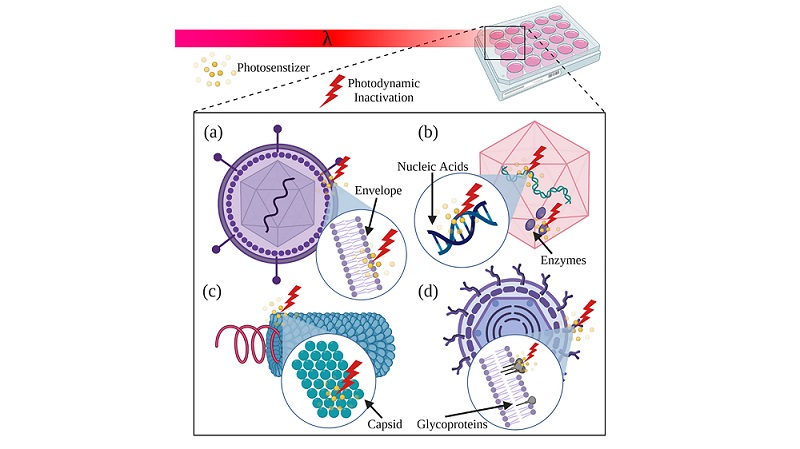Adding antibodies to photodynamic therapies can bolster their efficacy, according to research conducted by Texas A&M University and the University of São Paulo. The work reviewed the existing approaches to photodynamic therapies and provided a model to help expedite development of photodynamic therapies as a rapid response to emergent pandemics.
In photodynamic therapy (PDT), photosensitizers composed of dyes and other light-reacting compounds are typically administered intravenously or are applied topically to the area where treatment is needed; they are then absorbed by microbes or cancer cells. When light is applied, the compounds react, forming reactive oxygen species — toxic oxygen molecules that kill the cancer cells or pathogen.

Schematic illustration of photodynamic inactivation of various viruses. Courtesy of Vladislav Yakovlev/Texas A&M University.
In antibody photodynamic therapy (aPDT), photosensitizers are attached to viral antibodies to bolster the immune response.
“The beauty of this treatment is that antibodies are typically available early,” Texas A&M University professor of biomedical engineering Vladislav Yakovlev told Photonics Media.
The antibody is modified by attaching a small light-absorbing molecule, which, once illuminated, transfers the photon energy to the targeted virus particles, thus destroying them. In this method of PDT, harm to host cells and healthy tissues is reduced.
Applying the photosensitizers to antibodies is not a difficult process, Yakovlev said, as antibodies are already used for fluorescence-based detection, meaning that the process exists within the current workflow.
“The idea is somewhat similar to what Kary Mullis, the Nobel Prize winner and the inventor of PCR, suggested some time ago,” Yakovlev told Photonics Media.
Mullis’ idea was to attach something to the antibody that the body already knows how to get rid of. However, this is more difficult, Yakovlev said, “since it strongly relies on individual immune response, while in our approach the efficiency simply depends on the light being delivered to those targeted absorbers.”
Yakovlev noted that side effects are not likely, provided that the photosensitizers or antibodies themselves are not harmful to the body. Treatments can be repeated multiple times to reduce the body’s viral load.
“In other words, it is a potentially universal remedy for any infection,” Yakovlev said. “It can complement any other treatment and can be made quickly available.”
The researchers developed a mathematical model to compare PDT to other antiviral treatment by focusing on three parameters critical in modifying the treatment response to determine efficacy: photosensitizer, light, and oxygen.
Molecular oxygen is considered intrinsic to the relevant biological system as it is present at the site of infection. However, the light dose and photosensitizer concentration are malleable parameters in achieving efficient treatment results.
“The key things here are availability of antibodies in sufficient quantities, efficient light absorption, and efficient light delivery,” Yakovlev told Photonics Media.
Certain areas of the body could pose challenges, as the level of tissue penetration offered by light is limited.
“None of those are unresolvable problems, but they do need some more research work to be done to improve the efficiency,” Yakovlev said.
The research was published in Applied Physics Reviews (www.doi.org/10.1063/5.0044713).